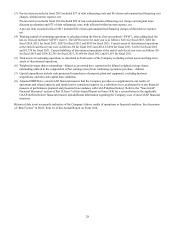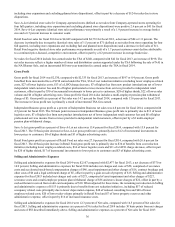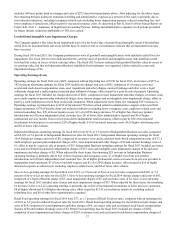Albertsons 2015 Annual Report Download - page 35
Download and view the complete annual report
Please find page 35 of the 2015 Albertsons annual report below. You can navigate through the pages in the report by either clicking on the pages listed below, or by using the keyword search tool below to find specific information within the annual report.
33
$87 increase from an additional week of sales in fiscal 2015, a $47 improvement from positive identical store sales of 1.0 percent
(defined as net sales from stores operating for four full quarters, including store expansions and excluding fuel and planned store
dispositions) and $17 of higher fuel sales, offset in part by lower sales from three store closures. Retail Food positive identical
store sales performance was primarily a result of a 2.4 percent customer count increase, offset in part by a 1.4 percent decrease in
average basket size.
Corporate net sales for fiscal 2015 include fees earned under the TSA of $194, compared with $240 last year, a decrease of $46.
The net sales decrease reflects a one-year transition fee earned under the TSA in fiscal 2014 of $60, offset in part by higher fees
earned during the first quarter of fiscal 2015 due to the timing of the sale of NAI and $4 from an additional week of sales in fiscal
2015.
Gross Profit
Gross profit for fiscal 2015 was $2,578, compared with $2,530 last year, an increase of $48 or 1.9 percent. Gross profit as a
percent of Net sales was 14.5 percent for fiscal 2015, compared with 14.7 percent last year. TSA fees included within Gross profit
declined by $46, impacting Gross profit as a percent of Net sales by 30 basis points. Last year's Gross profit included a $3
multiemployer pension plan withdrawal charge. The remaining $91 increase in Gross profit is primarily due to $126 of higher
gross profit from increased sales, $12 of lower logistics costs and $9 of lower employee-related costs, offset in part by $33 of
incremental investments to lower prices to customers, higher shrink, stronger private brands’ pricing support and other margin
investments, an $18 higher LIFO charge and $12 of higher advertising costs.
Independent Business gross profit was $388 or 4.8 percent of Independent Business net sales, compared with $385 or 4.8 percent
last year. Independent Business gross profit for last year included a $3 multiemployer pension plan withdrawal charge. When
adjusted for this item, Independent Business gross profit for fiscal 2015 was approximately flat with last year, but included lower
logistics and employee-related costs and higher gross profit from increased sales volume, offset by stronger private brands’
pricing support and other margin investments and a higher LIFO charge.
Save-A-Lot gross profit was $684 or 14.8 percent of Save-A-Lot net sales, compared with $649 or 15.4 percent last year. Save-A-
Lot gross profit increased $59 from higher sales volumes. The 60 basis point decrease in Save-A-Lot gross profit rate is primarily
due to $15 of higher advertising costs and $12 of incremental investments to lower prices to customers and higher shrink.
Retail Food gross profit was $1,312 or 26.9 percent of Retail Food net sales, compared with $1,256 or 27.0 percent last year.
Retail Food gross profit increased $62 from higher sales volume. The 10 basis point decline in Retail Food gross profit rate is
principally due to an $11 higher LIFO charge and $10 of higher incremental investments to lower prices to customers and shrink,
offset in part by $7 of lower employee-related costs.
Selling and Administrative Expenses
Selling and administrative expenses for fiscal 2015 were $2,154 compared with $2,107 last year, an increase of $47 or 2.2
percent. Selling and administrative expenses for fiscal 2015 include net charges and costs of $75, comprised of non-cash pension
settlement charges of $64, a benefit plan charge of $5, store closure charges of $3, information technology intrusion costs, net of
insurance recoverable, of $2 and severance costs of $1. Selling and administrative expenses for last year included net charges and
costs of $58, comprised of severance costs and accelerated stock-based compensation charges of $46, asset impairment and other
charges of $16, contract breakage and other costs of $6 and a legal settlement charge of $5, offset in part by a gain on sale of
property of $15. The remaining $30 increase in Selling and administrative expenses is primarily due to $102 of higher expenses
from increased sales volume and $8 of higher employee-related costs, offset in part by $43 of lower net periodic pension expense
and $42 of reduced depreciation and amortization expense and occupancy costs.
Selling and administrative expenses for fiscal 2015 were 12.1 percent of Net sales, compared with 12.3 percent of Net sales last
year. Selling and administrative expenses as a percent of Net sales for fiscal 2015 included 40 basis points from the net charges
and costs of $75 described above. Selling and administrative expenses as a percent of Net sales for last year included 30 basis
points from the net charges and costs of $58 described above. The remaining 30 basis point net reduction in Selling and
administrative expenses as a percent of Net sales is primarily due to lower net periodic pension expense and reduced depreciation
and amortization expense and occupancy costs, offset in part by higher employee-related costs.
























